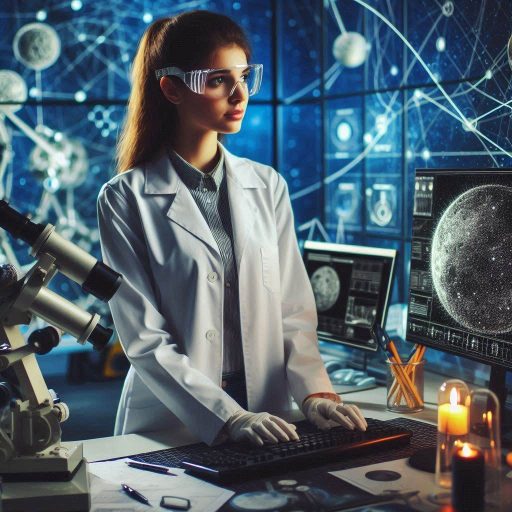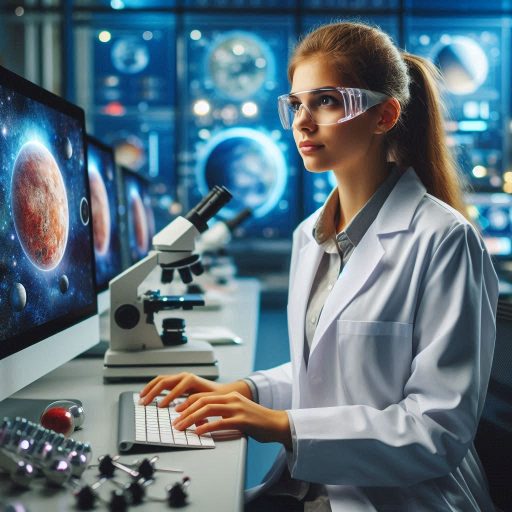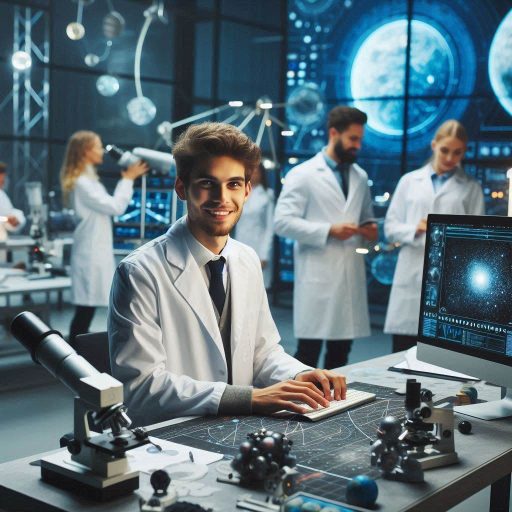Introduction
Space missions explore the cosmos, gathering valuable information about celestial bodies and phenomena.
These missions range from robotic probes to crewed spacecraft.
They collect data on planets, moons, asteroids, and more.
This data provides insights into the formation and evolution of our solar system.
Data collection is crucial for understanding our universe.
Scientists analyze various types of information, including images, spectra, and measurements.
This data helps them decipher the chemical composition and physical properties of distant objects.
Accurate data enables researchers to make informed hypotheses about celestial phenomena.
Space scientists utilize data from missions in diverse ways.
They create detailed maps of planetary surfaces, revealing geological features and changes.
Scientists also monitor atmospheric conditions, which helps predict space weather impacts on Earth.
They conduct simulations using mission data to understand complex processes in space.
Moreover, data analysis often leads to unexpected discoveries.
For example, scientists have found signs of water on Mars and moons like Europa.
By leveraging data from space missions, scientists expand our knowledge of the universe.
Their work shapes our understanding of Earth’s place in the cosmos.
Each mission contributes to a larger picture, enriching our scientific legacy.
Pre-mission planning
Planning for a Space Mission
Planning a space mission involves extensive preparation and coordination.
Scientists and engineers begin by defining the mission‘s purpose.
They outline specific objectives that guide the entire project.
Each objective helps determine the data needed for analysis.
A clear mission plan ensures effective resource allocation and timeline management.
Teams conduct thorough research to understand the mission’s scientific goals.
They evaluate existing technologies and identify necessary advancements.
This process often involves developing new instruments to gather specific data.
Scientists and engineers collaborate to create a detailed mission proposal.
This proposal outlines objectives, timelines, and budget estimates.
Once the proposal is approved, teams initiate detailed design phases.
They assess various scenarios to ensure mission success.
Teams conduct simulations to predict outcomes and identify potential challenges.
These simulations help refine mission parameters and enhance safety measures.
Setting Objectives and Goals for Data Collection
Setting clear objectives and goals is crucial for effective data collection.
Scientists establish what they aim to achieve through the mission.
These goals can range from studying a planet’s atmosphere to analyzing cosmic radiation.
Each objective shapes the instruments and methods used for data collection.
Teams develop specific metrics to measure success.
They identify key performance indicators (KPIs) relevant to each objective.
This structured approach ensures that data collection aligns with scientific goals.
It also helps prioritize tasks and resources during the mission.
After launch, teams continuously monitor data collection processes.
They analyze real-time data to ensure objectives are being met.
If issues arise, teams can adapt their strategies to maintain mission integrity.
This flexibility is essential for overcoming unexpected challenges in space.
Collaboration Between Scientists and Engineers
Collaboration between scientists and engineers is vital for mission success.
Scientists provide expertise in their specific fields, defining research goals.
Engineers translate these goals into practical designs and systems.
This partnership fosters innovative solutions to complex problems.
Regular communication ensures alignment between scientists and engineers.
They hold meetings to discuss progress, challenges, and adjustments.
This open dialogue allows for timely decision-making and problem-solving.
Engineers often rely on scientists for insights during design phases.
Conversely, scientists depend on engineers to implement their ideas effectively.
Interdisciplinary collaboration extends beyond immediate teams.
Various specialists contribute to the mission, including software developers and data analysts.
Each expert plays a role in refining data collection processes.
This teamwork enhances the mission’s overall effectiveness and success.
Planning for a space mission requires thorough preparation and collaboration.
Setting clear objectives and goals guides effective data collection.
The partnership between scientists and engineers is crucial in achieving mission success.
As a result, space scientists can gather invaluable data, enhancing our understanding of the universe.
Through effective teamwork and planning, these missions lead to groundbreaking discoveries that benefit humanity.
Read: Botany Career Fairs and Networking Events
Data Collection Process
Explanation of Different Types of Data Collected During Space Missions
Space scientists collect various types of data during missions.
They gather information about celestial bodies, atmospheres, and cosmic phenomena.
Instruments measure temperature, pressure, and chemical compositions.
Scientists also track radiation levels and magnetic fields in space.
Observations can include images and spectroscopic data.
Cameras capture high-resolution images of planets, moons, and asteroids.
Spectrometers analyze light to determine an object’s composition.
This data helps scientists understand the universe’s origins and behavior.
Remote sensing data provides insights into planetary surfaces.
Spacecraft equipped with radar and lidar can create detailed topographical maps.
This data is essential for studying geological processes on other planets.
Each type of data contributes to a comprehensive understanding of our solar system.
Instruments and Technology Used for Capturing Data
Space missions utilize advanced instruments for data collection.
Telescopes equipped with sensitive cameras capture images from great distances.
Satellites use various sensors to gather information about Earth’s atmosphere and surface.
Spectrometers analyze light from stars and galaxies, revealing their composition.
These instruments help scientists study the universe’s physical properties.
Robotic landers and rovers also collect data directly from planetary surfaces.
They examine soil, rocks, and environmental conditions.
Technological advancements improve data collection capabilities.
For example, the James Webb Space Telescope features innovative instruments that enhance image quality.
These advancements enable scientists to capture more detailed data than ever before.
Challenges Faced During Data Collection in Outer Space
Collecting data in outer space presents numerous challenges.
First, the extreme conditions can damage instruments.
Spacecraft face harsh temperatures, radiation, and micrometeoroid impacts.
Engineers design equipment to withstand these conditions, but failures can occur.
Communication with spacecraft also poses challenges.
Signals must travel vast distances, resulting in delays.
This lag can complicate real-time data collection and analysis.
Scientists must plan missions carefully to minimize these issues.
Furthermore, data transmission can be limited by bandwidth constraints.
Space missions often operate in remote areas, making reliable communication difficult.
Scientists must prioritize essential data for transmission, potentially losing valuable information.
Lastly, interpreting the data can be complex.
Scientists must analyze vast amounts of information, requiring advanced algorithms and models.
They face challenges in ensuring accuracy and reliability.
Collaborating with interdisciplinary teams helps scientists overcome these hurdles.
Space scientists rely on various types of data collected during missions.
They utilize advanced instruments and technology to capture valuable information.
However, challenges arise from the harsh conditions of space and the complexities of data interpretation.
Despite these obstacles, scientists continue to make groundbreaking discoveries, expanding our understanding of the universe.
Read: Preparing for a Botany PhD: Tips and Advice
Data analysis
Overview of How Space Scientists Analyze Collected Data
Space scientists analyze data collected from various space missions to gain insights about the universe.
They receive vast amounts of data from satellites, rovers, and telescopes.
Each mission generates unique datasets, requiring careful analysis.
Scientists categorize this data based on its origin and type.
For instance, data may come from planetary missions or deep-space observations.
Scientists use multiple techniques to analyze this data effectively.
They begin by cleaning the datasets to remove noise and errors.
Cleaning ensures that the data reflects accurate measurements and observations.
After preprocessing, scientists apply statistical methods to interpret the information.
These methods help identify patterns and relationships within the data.
Moreover, visualizing data plays a crucial role in analysis.
Scientists create graphs, charts, and maps to illustrate their findings.
Visualization helps them understand complex information quickly.
It also facilitates communication with other scientists and the public.
Utilization of Advanced Software and Algorithms
Advanced software and algorithms are essential tools for space scientists.
These technologies streamline the data analysis process significantly.
Scientists often use programming languages like Python or R for data manipulation.
These languages support various libraries that simplify complex calculations and analyses.
Machine learning algorithms also enhance data processing capabilities.
Scientists use these algorithms to identify trends and anomalies in large datasets.
For example, they can train models to detect exoplanets based on light curves from stars.
This automation accelerates the discovery process and increases accuracy.
Additionally, simulation software allows scientists to model space phenomena.
They can replicate conditions in space to study their effects on data.
These simulations provide a deeper understanding of the underlying mechanisms.
They help predict future events, such as asteroid impacts or solar flares.
Importance of Accurate and Consistent Data Interpretation
Accurate and consistent data interpretation is crucial in space science.
Misinterpretations can lead to flawed conclusions and misguided research.
Scientists must ensure that their analytical methods are robust and reliable.
Rigorous testing and validation of algorithms help minimize errors in analysis.
Collaboration among scientists enhances the reliability of data interpretation.
Peer review processes enable researchers to share insights and critique methodologies.
This collaborative environment promotes the integrity of scientific findings.
Furthermore, maintaining transparency in data handling fosters trust.
Scientists must document their methodologies and share datasets with the broader community.
Open access to data encourages independent verification of results.
This approach strengthens the overall credibility of space science research.
Space scientists meticulously analyze data from space missions using advanced software and algorithms.
They emphasize accurate and consistent data interpretation to ensure reliable findings.
Through collaboration and transparency, they enhance the integrity of their research, contributing to our understanding of the universe.
Each analysis leads to new discoveries, helping humanity explore the cosmos.
Read: Interdisciplinary Research: Botany and Other Sciences

Discoveries and Findings
Key Discoveries Made by Space Scientists Using Mission Data
Space scientists have made groundbreaking discoveries using data from various space missions.
One significant finding came from the Hubble Space Telescope.
Hubble revealed the existence of exoplanets, expanding our understanding of potential life beyond Earth.
This discovery opened new avenues for research and exploration.
Another critical discovery was made by the Mars rovers, Spirit and Opportunity.
These rovers confirmed the presence of liquid water on Mars in the past.
This finding raised the possibility of ancient microbial life on the planet.
Additionally, the Curiosity rover has analyzed Martian soil and atmosphere, providing insights into its habitability.
The Voyager missions provided invaluable data about the outer planets.
Voyager 1 and 2 sent back images and information about Jupiter, Saturn, Uranus, and Neptune.
These discoveries have transformed our knowledge of these distant worlds and their moons.
For instance, Voyager data revealed the complex atmospheric dynamics of Jupiter and Saturn’s stunning ring systems.
The Kepler Space Telescope significantly contributed to identifying Earth-like exoplanets in habitable zones.
Its data led to the discovery of thousands of new planets.
Researchers now focus on these exoplanets to assess their potential for life.
Impact of These Findings on Our Understanding of the Universe
The findings from various space missions have profoundly impacted our understanding of the universe.
They have challenged previous beliefs about planetary formation and evolution.
For example, the discovery of exoplanets has reshaped theories about how planets form around stars.
Understanding Mars’s geological history has provided context for studying Earth’s past.
The presence of water on Mars suggests that similar processes may have occurred on our planet.
This knowledge helps scientists comprehend the potential for life elsewhere in the universe.
The data from the Hubble Space Telescope has also revealed the expansion of the universe.
Hubble’s observations led to the discovery of dark energy, which drives this expansion.
This finding fundamentally altered our understanding of cosmic evolution.
Contributions to Scientific Research and Knowledge
The contributions of space scientists to scientific research and knowledge are immense.
Their discoveries fuel ongoing research in astrophysics, planetary science, and cosmology.
Each mission provides a wealth of data that researchers analyze and share with the scientific community.
Moreover, these findings inspire new technological advancements.
Instruments developed for space missions often lead to innovations on Earth.
For instance, technologies used in satellite imaging have improved weather forecasting and disaster management.
Space scientists also collaborate with various disciplines.
Their research intersects with fields like biology, chemistry, and environmental science.
This interdisciplinary approach fosters a comprehensive understanding of complex scientific questions.
In summary, space scientists have made remarkable discoveries using mission data, significantly impacting our understanding of the universe.
These findings contribute to scientific research and inspire future exploration.
As technology and knowledge evolve, the quest to uncover the universe’s secrets continues, driven by the data collected from space missions.
Read: Women in Botany: Celebrating Pioneers and Leaders
Collaboration and Sharing
Importance of Collaboration Among Space Agencies and Scientists
Collaboration among space agencies and scientists is crucial for successful space missions.
Different agencies bring unique expertise and resources to the table.
For example, NASA, ESA, and JAXA often collaborate on missions to share knowledge.
This partnership maximizes the scientific output of each mission.
By working together, agencies can tackle complex challenges more effectively.
Joint missions also pool financial and technological resources.
Developing space missions can be expensive and time-consuming.
Collaborating allows agencies to distribute costs and risks.
For instance, the Mars Sample Return mission combines efforts from NASA and ESA.
This collaboration enhances mission feasibility and potential success.
Additionally, cross-agency collaborations foster innovation.
Scientists from various backgrounds contribute their insights.
This diversity of thought can lead to groundbreaking discoveries.
Collaboration encourages the sharing of best practices and methodologies.
These exchanges improve mission planning and execution.
Sharing of Data and Findings Within the Scientific Community
Sharing data and findings within the scientific community is essential for advancing space science.
Data collected from space missions is often rich and complex.
It contains valuable information about celestial bodies, atmospheres, and cosmic phenomena.
Scientists rely on this data to form hypotheses and draw conclusions.
Open data sharing accelerates scientific progress.
Researchers can analyze and interpret findings from different missions.
By collaborating, scientists build on each other‘s work, leading to more comprehensive understandings.
For example, data from the Hubble Space Telescope informs studies conducted by other observatories.
This interconnectedness enhances the scientific narrative and reveals new insights.
Moreover, many space agencies maintain open-access data repositories.
These platforms allow researchers worldwide to access mission data.
For instance, NASA’s Planetary Data System provides a wealth of information for scientists.
Such initiatives promote inclusivity and collaboration among researchers globally.
Encouraging Transparency and Openness in Data Sharing
Encouraging transparency and openness in data sharing is vital for the scientific community.
When agencies prioritize transparency, trust in scientific findings increases.
Openness fosters a culture of collaboration and innovation among researchers.
Transparent data sharing allows for independent verification of results.
Other scientists can replicate experiments or analyses, ensuring the validity of findings.
This process strengthens the overall scientific method and builds credibility.
Additionally, open data initiatives can inspire new research.
Researchers might discover new applications or insights by accessing shared data.
This innovation is crucial for advancing knowledge in space science and related fields.
Moreover, transparency can enhance public engagement with science.
When data is accessible, the public can understand and appreciate scientific endeavors.
This engagement fosters a sense of connection to space exploration.
Collaboration among space agencies and scientists plays a vital role in space missions.
Sharing data and findings within the scientific community accelerates progress and understanding.
Encouraging transparency and openness in data sharing fosters trust and innovation.
Together, these elements ensure that space science continues to thrive and inspire future generations.
Transform Your Career Today
Unlock a personalized career strategy that drives real results. Get tailored advice and a roadmap designed just for you.
Start NowDelve into the Subject: Ethical Considerations and Challenges in Zoology Research
Delve into the Subject: Marine Biology Career Paths and Options
Application in other fields
Exploration of How Data from Space Missions is Used in Other Scientific Fields
Space missions generate vast amounts of data that benefit various scientific fields.
Scientists analyze this data to gain insights into Earth and beyond.
They use advanced technologies to process and interpret the information collected.
For example, satellite imagery provides crucial data for climate research.
It helps scientists monitor changes in the Earth’s atmosphere and surface.
Data from space missions also contributes to geology and oceanography.
Earth observation satellites track geological changes like earthquakes and volcanic activity.
They provide valuable information on ocean currents, temperatures, and health.
Researchers rely on this data to study ecosystems and marine life.
Furthermore, space data assists in agriculture and urban planning.
Farmers utilize satellite imagery to monitor crop health and optimize yields.
Urban planners use data to understand land use and infrastructure needs.
By integrating space data, these fields make informed decisions that benefit society.
Examples of How Space Mission Data Has Benefited Earth Sciences, Technology, and Medicine
Space mission data has significantly impacted Earth sciences, technology, and medicine.
In Earth sciences, satellite data enhances weather forecasting and disaster management.
Meteorologists analyze satellite imagery to predict severe weather events accurately.
This technology saves lives and minimizes property damage during disasters.
In technology, innovations from space missions often find applications on Earth.
For instance, materials developed for space exploration lead to advances in manufacturing.
Lightweight materials used in spacecraft can improve automotive and aerospace industries.
These innovations drive economic growth and enhance everyday products.
In medicine, data from space missions contributes to health research.
For example, researchers use satellite data to study the spread of diseases.
They analyze environmental factors affecting public health.
Additionally, imaging technologies developed for space missions improve medical imaging techniques.
These advancements lead to better diagnostic tools and patient outcomes.
Cross-Disciplinary Collaborations and Innovations
Cross-disciplinary collaborations fuel innovations stemming from space mission data.
Scientists from various fields work together to maximize the benefits of this information.
For instance, climatologists and biologists collaborate to study climate change impacts on ecosystems.
They integrate satellite data with biological research to understand these complex interactions.
Moreover, partnerships between space agencies and universities foster research opportunities.
Students and faculty members participate in projects analyzing space data.
These collaborations enhance educational experiences and promote scientific discovery.
Industry collaborations also play a vital role in advancing technology.
Companies partner with space agencies to develop new tools and applications.
This cooperation leads to groundbreaking advancements in fields like telecommunications and environmental monitoring.
Data from space missions profoundly influences various scientific fields.
It enhances Earth sciences, technology, and medicine while fostering cross-disciplinary collaborations.
By leveraging this data, scientists develop innovative solutions to pressing global challenges.
As research continues, the impact of space mission data will only grow, benefiting society and the planet.
Learn More: Famous Anthropologists and Their Contributions
Find Out More: Nanotechnology in Medicine: Cutting-Edge Applications
Future of Space Data Utilization
Advancements in Technology for Data Collection and Analysis
Advancements in technology significantly enhance data collection and analysis in space missions.
Improved sensors capture more precise measurements of cosmic phenomena.
Enhanced imaging techniques provide detailed images of distant galaxies and planets.
Satellite systems now offer higher resolution and broader coverage than ever before.
This improvement allows scientists to gather more comprehensive datasets.
Artificial intelligence (AI) and machine learning also transform data analysis.
These technologies can quickly process vast amounts of information.
They identify patterns and anomalies that humans might overlook.
This capability accelerates the pace of research and discovery.
Advanced algorithms can analyze images from telescopes to detect exoplanets.
They can predict orbital mechanics with greater accuracy.
Robotics play a crucial role in data collection.
Robotic probes can explore hazardous environments that humans cannot access.
They gather samples and perform experiments in extreme conditions.
For example, the Mars rovers collect soil and atmospheric data.
These robots transmit valuable information back to Earth for analysis.
Potential for New Discoveries and Breakthroughs
The potential for new discoveries and breakthroughs in space exploration is immense.
Enhanced data collection opens doors to previously unreachable knowledge.
Scientists can investigate black holes, dark matter, and the early universe.
These mysteries hold answers to fundamental questions about existence and our place in the cosmos.
Increased data also aids in understanding planetary systems.
Researchers can study the composition of distant exoplanets.
They can assess habitability and the potential for life beyond Earth.
This information drives the search for extraterrestrial life and expands our understanding of biology.
Collaboration among international space agencies fosters innovative discoveries.
Shared data from missions, such as the Hubble Space Telescope, enhances research.
Joint projects lead to significant findings that individual agencies might not achieve alone.
This collaboration nurtures a global scientific community united by a common goal.
Importance of Continued Investment in Space Missions
Continued investment in space missions is vital for scientific progress.
Funding ensures that researchers have access to advanced technology and resources.
Governments and private sectors must prioritize space exploration to maintain momentum.
Investing in space initiatives yields benefits that extend beyond astronomy.
Advances in space science drive innovation in various fields.
Technology developed for space often finds applications on Earth.
For instance, satellite technology enhances telecommunications and weather forecasting.
These innovations improve everyday life and contribute to economic growth.
Moreover, space missions inspire future generations to pursue STEM careers.
Investment in education and research encourages students to engage with science.
As more individuals enter the field, fresh ideas and perspectives emerge.
In essence, advancements in technology enhance data collection and analysis in space missions.
These improvements lead to new discoveries and breakthroughs in understanding the universe.
Continued investment in space exploration is crucial for scientific progress and innovation.
As we explore the cosmos, we unlock secrets that can transform our understanding of existence itself.
Conclusion
Data from space missions plays a significant role in advancing our understanding of the universe.
Scientists collect vast amounts of information from satellites, rovers, and telescopes.
This data reveals details about planetary atmospheres, surface compositions, and cosmic phenomena.
Analyzing this information helps us learn about the origins and evolution of celestial bodies.
Space scientists play a crucial role in utilizing and interpreting this data.
They develop advanced algorithms and models to analyze complex datasets.
Their expertise allows them to identify patterns and make sense of intricate information.
This interpretation drives our understanding of fundamental questions about the universe.
Through collaboration, scientists share insights and enhance collective knowledge.
Continued research and exploration in space science remain essential.
With every mission, we uncover new information that challenges existing theories.
Investing in technology and training for scientists ensures we maximize the benefits of collected data.
Encouraging interdisciplinary collaboration can lead to innovative discoveries.
By supporting further research, we pave the way for groundbreaking advancements.
Engaging the public in space science inspires future generations to explore the cosmos.
Let us prioritize and support efforts that enhance our understanding of the universe and its mysteries.
[E-Books for Sale]
The Big Book of 500 High-Paying Jobs in America: Unlock Your Earning Potential
$19.99 • 500 High-Paying Jobs • 330 pages
Explore 500 high-paying jobs in America and learn how to boost your career, earn more, and achieve success!
See All 500 High-Paying Jobs of this E-Book
1001 Professions Without a Degree: High-Paying American Jobs You Can Start Now
$19.99 • 1001 Professions Without a Degree • 174 pages
Discover 1001 high-paying jobs without a degree! Unlock career tips, skills, and success strategies for just $19.99!




